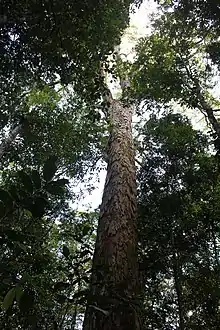| Dinizia | |
|---|---|
 | |
| Dinizia excelsa | |
| Scientific classification | |
| Kingdom: | Plantae |
| Clade: | Tracheophytes |
| Clade: | Angiosperms |
| Clade: | Eudicots |
| Clade: | Rosids |
| Order: | Fabales |
| Family: | Fabaceae |
| Subfamily: | Caesalpinioideae |
| (unranked): | Dimorphandra Group A |
| Genus: | Dinizia Ducke[1] |
| Species | |
Dinizia is a genus of flowering plants in the legume family, Fabaceae. It was believed to be monotypic until 2017, when Dinizia jueirana-facao was described. Dinizia is native to Brazil (North Region and Central-West Region), Guyana and Suriname. Both species are colossal forest trees.[1]
Fossilised leaves and fruit discovered in North America provide evidence of a Dinizia-like ancestor that first occurred in south-eastern North America during the Eocene epoch. The modern genus, however, is confined to South America, where it occurs in non-flooded parts of the Amazonian forests of Guyana, Suriname and seven states of North and Central-West Brazil.[2]
Species
As of December 2019, Plants of the World Online has accepted two species:[1]
- Dinizia excelsa Ducke
- Dinizia jueirana-facao G.P.Lewis & G.S.Siqueira
References
Wikimedia Commons has media related to Dinizia.
- 1 2 3 "Dinizia Ducke". Plants of the World Online. Royal Botanic Gardens, Kew. Retrieved 2019-12-19.
- ↑ Lewis, G. P.; Siqueira, G. S.; Banks, H.; Bruneau, A. (2017). "The majestic canopy-emergent genus Dinizia (Leguminosae: Caesalpinioideae), including a new species endemic to the Brazilian state of Espírito Santo". Kew Bulletin. 72 (3): 48. doi:10.1007/s12225-017-9720-7. PMC 6961463. PMID 32009686.
This article is issued from Wikipedia. The text is licensed under Creative Commons - Attribution - Sharealike. Additional terms may apply for the media files.